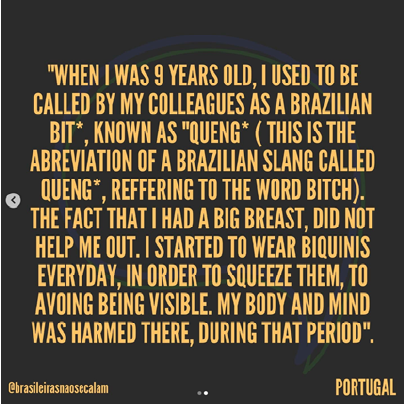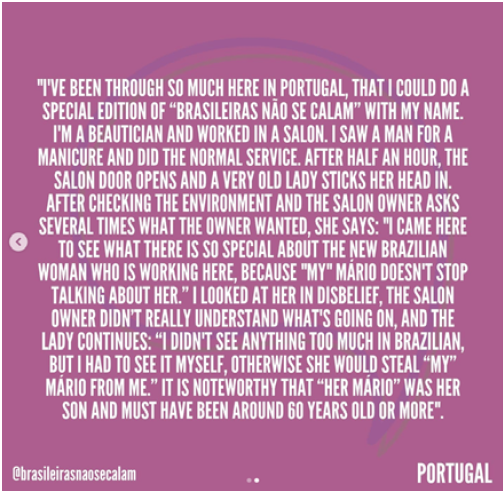Serviços Personalizados
Journal
Artigo
Indicadores
-
 Citado por SciELO
Citado por SciELO -
 Acessos
Acessos
Links relacionados
-
 Similares em
SciELO
Similares em
SciELO
Compartilhar
Comunicação e Sociedade
versão impressa ISSN 1645-2089versão On-line ISSN 2183-3575
Comunicação e Sociedade vol.41 Braga jun. 2022 Epub 20-Jun-2022
https://doi.org/10.17231/comsoc.41(2022).3697
Thematic Articles
Cyberspace as Denunciation: Harassment and Discrimination Linked to Coloniality in the Project Brasileiras Não Se Calam
iInstituto de Comunicação da NOVA, Faculdade de Ciências Sociais e Humanas, Universidade Nova de Lisbon, Lisboa, Portugal
iiInstituto de Comunicação da NOVA, Faculdade de Ciências Sociais e Humanas, Universidade Nova de Lisboa, Lisbon, Portugal
O estereótipo da mulher latina é comummente associado à sexualidade. Dentre elas, as mulheres brasileiras parecem carregar ainda mais este estigma mundo fora. Enquanto imigrantes, interseccionadas por outras matrizes de opressão além de género e raça, por exemplo, estas mulheres veem-se sujeitas a diversas marcas ainda remanescentes da colonialidade eurocêntrica que as inferioriza e silencia (Mignolo, 2000/2003), o que é agravado quando o país de emigração é o seu colonizador. Este artigo explora a utilização do ciberespaço como campo de denúncia e ativismo feminista através do estudo de caso do perfil @brasileirasnaosecalam, a partir da análise de conteúdo. O projeto surge na rede social digital Instagram com o intuito de denunciar, de maneira anónima, assédios, discriminações e preconceitos que mulheres imigrantes brasileiras sofrem em Portugal, especificamente por carregarem consigo a sua própria nacionalidade. Assim, através do ciberativismo, também feminista, as mulheres dispõem de um novo ciclo político de oportunidades impulsionadas pela construção e consolidação de laços entre elas ao redor do globo, rompendo binarismos, também entre primeiro e terceiro mundo, num apelo à articulação entre fronteiras (Timeto, 2019). Constata-se a relevância de empreender uma visão ontológica que se apoie numa perspetiva feminista decolonial e interseccional que utiliza o ciberfeminismo como aliado de interconexão entre o espaço digital e o real.
Palavras-chave: ciberativismo; imigração; xenofobia; Brasileiras Não Se Calam; ciberfeminismo
The stereotype of the Latin woman is commonly associated with sexuality. Brazilians seem to be particularly burdened by this stigma among Latin women worldwide. As immigrants, intersected by other matrices of oppression in addition to those of gender and race, for example, these women bear various marks remaining from Eurocentric coloniality that belittles and silences them (Mignolo, 2000/2003), a circumstance that is aggravated when the country of emigration is their coloniser. This article explores resorting to cyberspace as a forum for denunciation and feminist activism through a case study of the profile @brasileirasnaosecalam based on content analysis. The project appeared on the digital social network Instagram to anonymously report the harassment, discrimination and prejudice that Brazilian immigrant women suffer in Portugal, specifically for carrying their own nationality. Thus, through cyberactivism, which is also feminist activism, women are now experiencing a new cycle of political opportunities driven by the building and consolidation of ties among them around the globe, breaking down binarisms, including those between the first and the third world, in an appeal to cross-border articulation (Timeto, 2019). That shows the relevance of pursuing an ontological vision underpinned by a decolonial and intersectional feminist perspective that uses cyberfeminism as an ally to interconnect the digital and the real space.
Keywords: cyberactivism, immigration, xenophobia; Brasileiras Não Se Calam, cyberfeminism
1. Introduction
The notion of “Brazilian woman” bears a series of preconceived stereotypes and stigmas that act as barriers to integration, especially in Portugal - the colonising country. The Portuguese cultural imagination and social representations of Brazil and the Brazilians have deep historical roots in the process of colonisation (most acutely expressed by stereotypes that combine desire, fear and phobia), having achieved greater prominence and visibility as the Brazilian immigration into Portugal intensified, particularly from the 2000s onward (Gomes, 2018; Mingas, 2020).
Exoticism and sensuality that are seen as innate have been, in equal measure, a part of the social representations of the Brazilian woman since the start of colonialism. Ester Mingas (2020) argues that those representations were updated by various social processes and dynamics, such as the dissemination of the Lusotropicalist theory in Portugal and the popularity of Brazilian telenovelas in the country (starting in the 1970s), which contributed to the circulation and reproduction of a host of stereotypes already deep-seated by the time the first waves of Brazilian immigrants arrived.
According to the report on immigration, borders and asylum (Machado et al., 2020) produced in 2019 by the Portuguese Immigration and Borders Service, Brazilians are the main community of foreigners residing in Portugal, amounting to 25.6% of their total number, which is already the highest since 2012. Among them, women make up the largest share of the population, which is characteristic of the international process of feminisation of migration, in which women are agents of the migratory flow (Jerónimo, 2019).
Bound by various layers of oppression, aggravated by being colonised bodies in the colonising country, these women face countless forms of xenophobic, colonial, ethnic and, above all, sexual prejudice (Piscitelli, 2008), which transform them into and advertise them as available bodies.
The emergence of cyberspace allowed several minorities, such as these women, to create networked communities based on identifying a commonality and creating new opinions and discourses beyond those previously in place (Martino, 2014). Such is the case of the project Brasileiras Não Se Calam (Brazilian Women Will Not Be Silent), which was born as an Instagram profile to denounce the prejudice suffered by Brazilian immigrant women in Portugal.
Taking the project Brasileiras Não Se Calam as a case study, we aim to explore the use of digital space as a forum for denunciation and disseminating and spreading feminist activism, which can expand social awareness and mobilise the public opinion (Lamartine, 2021). The project is more than a profile for making reports on a digital social network, gaining traction outside cyberspace through a network of support among immigrant women; therefore, it embodies the authority of cyberfeminism and can effectively intervene in the relationships of power and culture, in public and political protests (Castells, 2012/2013).
Through content analysis (Bardin, 1997/2004), we studied the 3 months that followed the 1st year of the project since the organisers launched an annual report and obtained increased visibility in the media after that period. Therefore, posts from 14 July to 14 October 2021 were analysed, and the data were gathered under three broad themes, namely “stereotype”, “discredit”, and “xenophobia”, with the latter including a branch that we have titled “racism”.
This study discusses the need for an ontological approach that recognises the racialising logic introduced during the processes of colonisation, which established not only a relationship of inferiority between the colonised and the colonisers but also models and forms of political and social relations that are present to this today (Mendoza, 2016).
2. The Brazilian Woman in Portugal: Stereotypes and Sexism
The search for better living conditions is, in most cases, the great driver of immigration (Jerónimo, 2019), given the view that in the host country, the inconveniences of the country of origin would not exist. Nevertheless, Dias and Ramos (2019) point out that there is also a negative side due to the various vulnerabilities immigrants are subject to simply for being foreigners. Those vulnerabilities tend to be aggravated by the different types of prejudice that constrain, discriminate and exert violence against those individuals, especially in matters of gender.
Where the Brazilian immigrant community in Portugal is specifically concerned, it is possible to identify a combination of various stereotypes that directly interfere with the particulars of their integration and ultimately reduce the chance of finding better opportunities, whether on a personal or a professional level (Dias & Ramos, 2019).
These stereotypes tend to naturalise implicit differences by creating a social consensus about the various divergent categories, such as those based on ethnicity, race, gender and sexual orientation. Thus, through the reinforcement of subjective judgments, the historical inequalities linked to those categories are routinely validated and reproduced.
For Passador (2015), stereotypes act as a tool to segregate individuals, assigning them to certain areas of distinction associated with a lower status, which “enable us to quickly identify and typify categories of individuals and groups and establish their positions in the hierarchical game of inequality” (p. 25).
Brazilians are usually deemed synonymous with people who are always cheerful, festive and friendly and whose main characteristic or role is to entertain others. This role corresponds to a notion largely held and disseminated in Portugal and coexists with the roles of submission, laziness and, specifically for women, sexual availability (Padilla & Gomes, 2016; Queiroz et al., 2020).
Within immigration studies on what concerns Brazilian women, it is possible to observe a consolidation of the sexualised image attributed to them. It is a sensual and eroticised image specifically associated with the market of prostitution (Oliveira & Neto, 2016).
From the 1960s to the 1980s, the Brazilian government sought to launch campaigns to attract tourism, especially in Europe, which implicitly associated the country with an image of sexual tourism destination and Brazilian women with a position of objectification and availability for foreign tourists (Gomes, 2018).
This association became more widely known due to an issue of Times magazine titled “Europe’s New Red Light District” (Ripley, 2003) - an allusion to the famous street of prostitution in Amsterdam. The cover story related the ire of the Portuguese women of the city of Bragança towards Brazilian sex workers, in a movement that became internationally known as “mothers of Bragança”.
The Portuguese women blamed the Brazilian women for leading their husbands “astray” through the practice of prostitution. As Gomes (2018) explains, this incident depicted the Brazilian women as sinners, libertines and homewreckers, as the Portuguese women appeared under the protection of a divine mantle of chastity and, therefore, as exemplary mothers and faithful wives.
The movement emerged in May 2003 to expel the Brazilian sex workers from the city of Bragança to oppose what was seen as the destruction of morality and common decency (Gomes, 2018). The women drafted and signed a manifesto and promptly submitted it to the local authorities.
For many authors, the “mothers of Bragança” movement triggered the whole discussion on the role of the media and their discourse regarding Brazilian women. As João Carlos Correia (2014) explains, the protest became emblematic of the media’s stereotypical and xenophobic representations of gender.
The image of the Brazilian immigrant woman disseminated by the media is originally associated with the premiss of being an immigrant from a different national and ethnic group, one that is peripheral, racialised and economically inferior. It is also associated with Carnival culture, worship of physical beauty and sexualisation, resulting from the overlap between social markers of exclusion of a national identity (Pontes, 2004).
The propagation of hypersexuality as a characteristic of the Brazilian woman is echoed, as mentioned above, by the image sold abroad, which establishes the mixed-race woman as the main representation of Brazil. It is, therefore, the image of a colonial body; one which, as a subjugated body, is discursively constructed as available (Gomes, 2019), a synthesis of the imagination about the inhabitants of the tropics, whose sensuality is their main attribute (Queiroz et al., 2020).
From this perspective, it is important to highlight that the level of prejudice against Brazilian women in Portugal reaches peaks that are discrepant from those found in comparison with other countries of immigration, as the reports of the project Brasileiras Não Se Calam will also illustrate. Indeed, Brazilians are the largest community of foreigners residing in Portugal, with one out of every five immigrants living in Portugal originating from Brazil (Silva, 2019). That contributes to much greater visibility of Brazilian women within Portuguese society when compared to other immigrant communities, which reinforces and perpetuates a colonial mentality aligned with the prevailing discourses and with the relations established between the coloniser and the colonised (Queiroz et al., 2020).
Awareness of the feminisation of immigration became more widespread due to the feminist studies in academia. During the first decade of the 21st century, as the second migratory wave unfolded, Portugal experienced a strong growth in Brazilian immigrants, which increased significantly from 2012 onward (Gomes, 2018; Oliveira & Neto, 2016). The report on immigration, borders and asylum (Machado et al., 2020) expressed in numbers this feminine predominance in migration in 2019. There were 25,221 Brazilian women in total, against 23,575 Brazilian men.
The idea of the Brazilian woman as cheerful, sensual and sexually available (Padilla & Gomes, 2016) extends far beyond the view of the Brazilian woman as a sex worker. It means considering every Brazilian woman as a “colonial body”, a concept problematised by Fanon (1952/1986) regarding the Black body, which has been a target of oppression, discursively constructed as hypersexualised, racially fetishised and given animalistic and primitive features.
However, for Gomes (2018), what prevails is a Lusotropical discourse that omits several past forms of violence, preaching miscegenation and non-racism. That makes it more difficult to identify and conceive measures to address the issue, which must be urgently adopted so that they do not end up as veils that conceal prejudice by presenting gender equality and equal opportunities in a utopian manner (Carvalho & Fernandes, 2016).
It must also be said that, within the studies on migration between Brazil and Portugal, it is possible to perceive the third stage of migratory flows, which interferes with the profile of the Brazilian immigrant. Indeed, a third migratory wave is now underway, in which the presence of investors, retired persons and students in higher education have become more expressive (França & Padilha, 2018), with the latter being largely females (Machado et al., 2020).
3. Online Feminist Activism
Since technology became a part of the everyday life of individuals, its social role has suffered profound changes in what concerns their various forms of interaction. The internet now occupies a central space of social interaction and organisation, directly influencing how people communicate with each other, turning them into the very subjects of their own lives (Castells, 2012/2013).
This interference with the way people communicate results from the formation of cyberspace, which supports democratic and more horizontal communication, fostering collective action (Lamartine, 2021). Thus, cyberspace can create a new relationship between space and time, reconfiguring interaction itself, turning information and knowledge into sources of power because the subject reflects on the internet his/her dialogical connotation as he/she continues to seek integration into a digital community.
Digital activism as a phenomenon includes several practices that go beyond the geographical and spatial borders of the web; they create virtual spaces with their own configurations, which are defined by the participants’ adherence to a point in common, be it political, ideological or cultural (Martino, 2014), and culminate in social movements that prompt debate and action extending beyond the digital world.
In a reconfigured public sphere, social movements become self-reflective, questioning themselves both as groups and as individuals to move in unison towards the same social goal (Castells, 2012/2013). Specifically, concerning feminisms, this field has broadened the discussion about women and the inequalities they are conditioned by socially and within an electronic culture - women whose activism became known as cyberfeminism (Lamartine, 2021; Martinez, 2019).
Despite its diverse origins, some fragmented characteristics and, naturally, the appropriation of electronic networks, cyberfeminism allows for a reticular organisation since referring to the different feminisms by a single adjective or even insisting on using that name is quite controversial (Lemos, 2009). Nevertheless, the concept is attributed to the philosopher Sadie Plant and the Australian feminist collective VNS Matrix (Lamartine, 2021; Timeto, 2019).
This group published a manifesto in tribute to Donna Haraway, who proposed a new rereading of the feminist movements, though she did not directly use the term “cyberfeminism”. Haraway (1991) saw her ideas be adopted as a theoretical basis by different groups when she suggested analysing feminism in the context of new technologies, including the media, proposing network organisation and the appropriation of those technologies as forms of political activism (Lemos, 2009),
Haraway (1991) explains that the original focus of the technological field of activism was to call for women’s participation in these spaces to counter the masculinised and stereotypical image of this specific medium; she also recognises that, due to its multiform character, the movement brings together diversity and plurality of subjects who are willing to rebuild reality based on different types of discourses.
As Ferreira and Lima (2020) explain, as information and communication technologies challenged how people interact, cyberfeminism emerged as the answer to this specific issue within the feminist movement. Therefore, it is possible to observe how the feminist debate has moved away from organisations and institutions, giving rise to what many authors consider to be the fourth wave of the feminist movement, whose main feature is that it emerges from cyberspace, that is, from digital networks and platforms (Cochrane, 2013; Tomazetti, 2015).
The name of the fourth wave of feminism appeared in mid-2013 in the United States. Therefore, it is not a terminology coined by academia but disseminated by journalists and activists, highlighting how mobilisation can penetrate the various dimensions of feminism (Chamberlain, 2017).
Journalist Kira Cochrane (2013) defines four characteristics of this new phase of feminism as belonging to certain broad areas. The first concerns online feminism, the second deals with rape culture, in the third, she addresses humour to further feminist ideas. In the last, she presents inclusion and intersectionality, addressing harsh criticism of the old “universal woman”, “being challenged today to break down the symbolic and material borders that separate different strata of society in terms of class, ethnicity and sexuality” (Tomazetti, 2015, p. 497).
Based on the assertion that social movements are linked to confluences of emotions, it is possible to observe how feminism unites various subjects in sharing specific moments in history, which is evidence of what Chamberlain (2017) terms “affective temporality”. Affective temporality is framed as one of the constitutional characteristics of fourth-wave feminism, which has turned towards informational solidarity, where responsive activism is motivated by affection and the latter, in turn, catalyses action.
There have been countless digital protests - generated and motivated by feminist pages - with ample dissemination and significance for women’s debate on issues of rape, harassment, misogyny and machismo. By using digital social networks and their hashtags, many protests took over the globe in a collective outcry, as was the case of “#niunaamenos” in Argentina, “#meuamigosecreto” in Brazil, “#metoo” in the United States, among several others, some of which, like “slutwalk” and the international feminist strike “8M”, even became transnational.
The media saw these initiatives as a “women’s spring”, a combination of online call to action and taking of the streets by thousands of women, forming a cultural movement whose actions stem from the values and interests of its members, regardless of any institution to which it might belong (Castells, 2012/2013).
The consolidation of the feminist movement in cyberspace ensures a new cycle of political openness fostered by the creation of ties among women throughout the world (Lamartine, 2021), with online activism making it possible for the fourth wave of the feminist movement to be more plural and comprehensive in creating pillars that permanently interconnect mobilisation in the streets and on the web all around the world.
4. The Colonised Body in the Colonising Country: Intersectionality and Decoloniality
When addressing the subject of Brazilian immigrant women in Portugal, we must pay attention to the fact that we are dealing with a colonised body living in the colonising country. This circumstance bears various marks of coloniality itself and other matrices of oppression that intersect and combine. To this intersection of differences, we call “intersectionality”, a concept that should be viewed from a feminist standpoint, in this case, an intersectional standpoint.
The term “intersectionality” is thought to have been created by the American researcher Kimberlé Crenshaw in 1989 in an attempt to grasp the collision of structures and the simultaneous interaction of various definitions of identity. It was grounded in Black feminism and aimed at being applied in law studies to expose how a single axis of thought could undermine legal reasoning, the production of knowledge, and the fight for social justice (Cho et al., 2013; Collins, 2017; Martinez, 2019).
Hence, the notion of intersectionality emerges from recognising the various aspects that play a role in identity, such as race, class, ethnicity, sexuality and, of course, gender. These particular characteristics are identified as layers of oppression since, through intersectionality, one seeks to conciliate the claims based on gender with those of other minorities who are subjected to interaction with and daily interference of different structures (Martinez, 2019).
Intersectionality refers, therefore, to a form of political activism that must be placed in opposition to the cradles where difference is born, in a constant search for the conciliation of those efforts, being unable to operate under the social, material and intellectual terms fostered by neoliberalism (Collins, 2017; Martinez, 2019). “Intersectionality reveals what we cannot see when categories such as gender and race are conceived as separate from each other” (Lugones, 2008, p. 79).
When we think of the body as a category, narrowing it down even further to focus on the colonised body, the importance of reconfiguring the ideologies framed ontologically in the course of history and society becomes clear. However, as Mignolo (2000/2003) so eloquently puts it, what is at stake, is not to erase or eliminate what is Eurocentric in the various parts of the world but rather to rebuild the original epistemologies that were crushed and erased by the colonial process.
For that to happen, the feminist vision needs to go beyond intersectionality and expand through decolonial feminism, whose predominance and influence are centred in Latin America and the Caribbean. This theory can penetrate and establish a dialogue with feminist, poststructuralist, indigenous, Afro-Latin, African American, mixed-race and intersectionalist women (Mendoza, 2016).
The decolonial perspective challenges the standardisation of epistemic power, especially on a subjective level and emerges from a phallocentric, Eurocentric, patriarchal and capitalistic society grounded in generalised racialisation and categorisation measures. According to Mendoza (2016), this reinforces the power of decolonial studies by uniting crucial differences between coloniality, modernity and capitalism.
The Argentinian author María Lugones (2008) proposed the term after years of studying intersectionality itself, which for her demonstrates the exclusion of non-White women from history. Another key concept for the author is the notion of “coloniality of power” of Aníbal Quijano (as cited in Lugones, 2008), which acknowledges something that seems simple, namely that coloniality relationships did not end with the extinction of colonialism, especially within the realms of economy and politics (Ballestrin, 2013). As Lugones explains (2008): “crossing those two lines of analysis allows me to arrive at what I am calling, provisionally, a ‘modern-colonial system of gender’” (p. 74).
The colonial matrix of power structure is complex and levelled, with the concept of coloniality being broken down into various other domains (Mignolo, 2000/2003). For Ballestrin (2013), that matrix exercises control over the economy, power, nature and natural resources, gender and sexuality and knowledge subjectivity. Therefore, as the author states, the coloniality of power manifests itself in three different dimensions, comprising the coloniality of being, of knowledge and, of course, of power.
We share the view of Lugones according to which decolonial feminism considers, reviews and dialogues with the thinking and the work that thinkers, intellectuals, activists and fighters, whether feminist or not, who are of African, indigenous, mixed-race or peasant descent, racialised immigrants, as well as White scholars engaged in subaltern studies in Latin America and around the world have developed. (Miñoso, 2020, p. 8)
Thus, the modern/colonial gender system only exists due to the coloniality of power since a classification in terms of race, for example, is a necessary circumstance (Lugones, 2008). For Ballestrin (2013), the aim should be to understand how the colonised world constructs itself based on the discursive impressions of the coloniser and, similarly, how the colonised individual constructs him/herself through the allocution of his/her coloniser.
5. Brasileiras Não Se Calam: The Online Denunciation of Everyday Life
The hypersexualisation of Brazilian women’s bodies is widely spread in Portuguese society, through the music industry, through advertising and, naturally, through the media themselves. In mid-2020, in the show Big Brother Portugal, aired by the television channel TVI, one contestant, following several other racist and sexist remarks, stated that “Brazilian women have their legs spread already”, which sparked enormous debate on social network. That was the reason that led five friends, all of them Brazilian immigrants, to create a project aimed at reporting this type of discrimination.
In an interview for the newspaper Jornal de Notícias (Costa, 2020), the coordinators of the project, who wish to remain anonymous due to the countless threats they have already received, said that this incident made them realise that the prejudice against Brazilian women was clearly deep-seated in Portugal, to the point of being voiced in a television show.
At the end of July 2020, the project Brasileiras Não Se Calam gained a profile on the digital social network Instagram. In less than 1 month, it had reached 15,000 followers. By November 2021, the profile has more than 45,000 followers and maintains a good percentage of engagement, at 5.30%, according to the digital social metrics platform Phlanx (https://phlanx.com).
The profile publishes reports submitted via Instagram direct messages by Brazilian immigrant women. The posts are composed of text in Portuguese and English, and they are always made anonymously to protect the victims and avoid retaliation (Figure 1 and Figure 2).

Source: From Bandeira do Brasil. Até quando? [Photograph], by Brasileiras não se calam! [@brasileirasnaosecalam], 2021h, Instagram. (https://www.instagram.com/p/CWI7UmVDVPf/)
Figure 1: Instagram post @brasileirasnaosecalam

Source: From Bandeira do Brasil. 9 anos. Muita força pra nós. [Photograph], by Brasileiras não se calam! [@brasileirasnaosecalam], 2021d, Instagram. (https://www.instagram.com/p/CSCGJsFDMgx/)
Figure 2: Instagram post @brasileirasnaosecalam
According to the annual report published by the project, which covers the period from July 2020 to July 2021, 802 reports were registered in 39 countries. Portugal leads the ranking with 541 reports, followed by the United States with 38 reports, England with 31, Germany and Spain with 29 each and Italy with 26.
Among the reports related to Portugal, 354 did not specify the city. Lisbon, the capital, had 81 reports, followed by Porto with 37 and Coimbra with 13. The project’s coordinators also indicated in Jornal de Notícias (Costa, 2020) article mentioned above that most of the more violent and offensive reports always originated from Portugal, as illustrated in Figure 3.

Source: From Bandeira do Brasil. Nojo [Photograph], by Brasileiras não se calam! [@brasileirasnaosecalam], 2021e, Instagram. (https://www.instagram.com/p/CSz9YNlDPNf/)
Figure 3: Instagram post @brasileirasnaosecalam
The project provided support to 267 women by creating six areas of activity. The first, “brasileiras são voluntárias” (Brazilian women volunteer), brought together 43 women who coordinated all the other areas of assistance. “Brasileiras procuram” (Brazilian women seek) makes available the curriculums of women who are seeking a job, and 110 women have registered on the project’s website. “Brasileiras falam” (Brazilian women talk) is a support group for exchanging and sharing life experiences, in which 20 women participate weekly. “Brasileiras apoiam” (Brazilian women support) aims to provide professional psychological support, and 15 women have received assistance from it. In turn, “Brasileiras se apoiam” (Brazilian women support each other) is concerned with social support, and it has reached 10 women. Lastly, “Brasileiras denunciam” (Brazilian women report) provides legal assistance to victims, and it has served 31 women.
In addition to these areas of activity, the project offers academic and financial counselling, English and French classes, yoga activities and workshops, all of which are provided to immigrant women for free and through professionals who work as volunteers.
6. Case Study and Analysis: And 3 Months Later?
As explained above, the data published by the project in its annual report show that there is a higher level of reporting in Portugal - which accounts for more than half of all the reports made in 39 countries (541 reports, specifically). To check whether these numbers remained the same after the annual report was published and to prove the premiss of a colonised body in the colonising country, we used a 3-month section of the data, starting from the assessment launch date.
Thus, the period under analysis spans from 14 July 2021 to 14 October of the same year. One hundred eighty-six posts were collected, 14 of which were discarded from this analysis because they did not truly correspond to a report2. Out of 172 posts analysed, 132 concerned Portugal, therefore characterising the corpus of this study.
As Bardin (1997/2004) states, in content analysis, it is admissible to let the object speak for itself and for categorisations to appear in parallel with the analysis. With this in mind, we use the thematic analysis technique, according to which we divided the data into elements to group them into categories based on correspondence. The categories were thus divided into three thematic areas: “xenophobia”, “stereotype”, and “discredit”.
The first area was also the one that comprised the highest number of posts. There were 59 reports about “xenophobia”. This form of prejudice is directly linked to an individual’s nationality, which, in this case, was Brazilian. According to Passador (2015), prejudiced statements often go unnoticed since they ultimately become naturalised and widespread, cutting across generations and age brackets.
The reports in those posts displayed a high level of discrimination and repudiation from the Portuguese. Statements like “go back to where you came from” or “you don’t belong here/in this country” were widely mentioned and aggravated by prejudice against the “Brazilian” way of speaking.
It is also noticeable that when dealing specifically with colonialism in Portugal, there is, as mentioned above, a Lusotropical view that conceals or omits various forms of prejudice and violence under the idea of supposed Portuguese miscegenation deemed to create a diverse society (Gomes, 2018). Consequently, xenophobia veiledly presents itself in everyday life, in small cases like the one presented in Figure 4.

Source: From Bandeira do Brasil. Nojo [Photograph], by Brasileiras não se calam! [@brasileirasnaosecalam], 2021a, Instagram. (https://www.instagram.com/p/CRq9TauJh9V/)
Figure 4: Instagram post @brasileirasnaosecalam
Within that category, and based on the Lusotropical premiss, we decided to postulate a branch of that area, for as Lugones (2008) reminds us, “race is neither more mystical nor more fictitious than gender - both are powerful fictions” (p. 93). Racism was described in six of those posts, which corroborates the view of Padilla and Gomes (2016) when they conclude that the principle of Portuguese non-racism cuts across the whole of society.
The latest data from the European Social Survey (n.d.) of 2018/2019 stem from this view, showing Portugal as one of the most racist countries in Europe. The study investigated the presence of biological and cultural racism in the country, and it found that racist inclinations were stronger in older and less educated individuals. 62% of the respondents showed racist behaviour, while only 11% completely disagreed with racism. In other words, according to this research, one in three Portuguese people affirmed racist beliefs, as illustrated in Figure 5.

Source: From Bandeira do Brasil. Muita força pra gente! [Photograph], by Brasileiras não se calam! [@brasileirasnaosecalam], 2021g, Instagram. (https://www.instagram.com/p/CVnXhXmpGFm/)
Figure 5: Instagram post @brasileirasnaosecalam
The second category, with 58 reports, is “stereotype”. We decided to gather here all the reports that associated Brazilian women with pejorative adjectives like “whore”, “prostitute”, or “gold digger”. This category also includes reports of sexual and moral harassment and gynaecological violence.
The stereotypes attributed to Brazilian women tend to belittle, silence, diminish and racialise women, even if they are not Black. Indeed, in this situation specifically, the question of ethnicity is not only linked to race since, as Pontes (2004) explains, an ideology of mestiçagem (miscegenation) is present in the image of the woman who is sensualised and eroticised, irrespective of her colour; the mere fact of being Brazilian is enough to subject her to that process.
Since the “mothers of Bragança” incident, Brazilian women have been stigmatised as “man stealers”, a stigma they face every day. That was abundantly clear in all the reports that were analysed, and it also comes across in the comments left by several women who experienced similar situations and carried that erroneous notion with them, as shown in Figure 6.

Source: From Bandeira do Brasil. Agora, além dos maridos, também roubamos os filhos [Fotografia], by Brasileiras não se calam! [@brasileirasnaosecalam], 2021b, Instagram. (https://www.instagram.com/p/CR4p6PypfdI/)
Figure 6: Instagram post @brasileirasnaosecalam
The image of the Brazilian woman as cheerful, sensual and eroticised was found in all the reports and comments in the posts, such as “she had to be a whore”, “they came here to steal other women’s husbands”, “they’re only good to fool around and have fun with” and “they’re gold diggers! Always looking for easy money”. Figure 7 shows a complaint that is almost a complete reflection of all that was found in this category.

Source: From Bandeira do Brasil. Quem mais se sente assim? Comentem aí [Photograph], by Brasileiras não se calam! [@brasileirasnaosecalam], 2021c, Instagram. (https://www.instagram.com/p/CR_iQUJDWM3/)
Figure 7: Instagram post @brasileirasnaosecalam
The final category, which had fewer reports, was titled “discredit”. This category, comprising 15 reports, concerns cases in which intellectual belittling and questioning the curricular/professional background were reported.
An analogy could also be drawn with some of the comments included in the category “xenophobia”, which concerned the fact of speaking Brazilian Portuguese. Many reports and comments alluded to the idea that personal and professional integration would be nearly impossible without a change, especially a change in accent.
Intellectual belittling makes it hard to gain employment, except for care and cleaning, which is common in other European countries, as these areas are considered more feminised (Jerónimo, 2019). Regarding the report in Figure 8, most of the comments were supportive and shared the author’s feelings, as is the case of this comment of a follower who said,
I also see myself reflected in this report! It is extremely frustrating to see the lack of confidence in our work simply because we are Brazilian! Sometimes it is very hard to have to live with these issues daily! And the worst thing is that we begin to question our own potential!

Source: From Bandeira do Brasil. São professores… podem não gostar do fato de você ser brasileira??? [Photograph], by Brasileiras não se calam! [@brasileirasnaosecalam], 2021f, Instagram. (https://www.instagram.com/p/CTSBf4lDbr3/)
Figure 8: Instagram post @brasileirasnaosecalam
However, what must be highlighted in this category and most catches our attention as researchers, is that most reports were directed at the scientific community. There were reports of questioned curriculums, lower grades and fear of academic persecution, which is likely why there are not many reports of discrimination (or why their number is not expressive) within scientific institutions and activities (Padilla & Gomes, 2016).
From this perspective, Brazilian immigrant women who live in Portugal are riddled with sexual, national, colonial and ethnic differences (Piscitelli, 2008). These marks are noticeable in all the activities of the project Brasileiras Não Se Calam, from the texts of the reports to the social, legal and psychological forms of support that seek to counter this dissonance.
7. Conclusions
The legacy of coloniality leaves deep marks that mould the bodies of Brazilian immigrant women into living scars. The premiss of existing as a colonised body in the space of the coloniser contains a real ambivalence between greater closeness and prejudice, which imprint themselves on the various ways in which people interact and seek integration, even implying the negotiation of their own identities (Padilla & Gomes, 2016).
The reports of xenophobia, harassment, misogyny, machismo, racism, sexism and violence described in Brasileiras Não Se Calam reflect the marks of that coloniality and how they negatively impact the search for a new life associated with the idea of emigrating. The project uses the digital space as a forum for denunciation through feminist activism by promoting a current, though not new, debate. It denounces the structured relationship between the colonised and the coloniser by unveiling the conceptualisation of a Lusotropical discourse that omits and conceals several violations under the pretence of a diversified Portuguese society.
Significantly, the analysis performed here shows that the majority of the anonymous reports received by the project occur in Portugal (more than 76% of their total number), which prompts us to reflect on the insufficiency of the processes of historical reparation and the need, indeed the urgent need, to rethink social and epistemic configurations.
It would be desirable, at a later stage, to investigate the space that the project offers for the representation of other identities from the perspective of decolonial and intersectional feminisms, which are, in themselves, great epistemologies of reparation since the problematisation of biological dysmorphism is central to the understanding of the gender system (Lugones, 2008).
Consequently, recognising the immense interference of colonial processes both in terms of the gender divide and radicalisation is crucial for gaining an adequate understanding of past efforts. Therefore, we now advocate the merging of disruptive ontological views that, by being incorporated into feminist cyberactivism, will lend unprecedented support to feminism.
It is vital to envision a feminist movement that is also decolonial and intersectional, political and theoretical projects that challenge imperialist practices and colonial ones. A feminist movement that disregards the geographical limits that separate the forms of knowledge and experience of the north from those of the global south, uniting the various minority populations and their diverse activisms in the search for a feminism that is actually inclusive.
Acknowledgements
This work is funded with National Funds through the FCT - Fundação para a Ciência e Tecnologia under project Ref. 2021.07485.BD.
REFERENCES
Ballestrin, L. (2013). América Latina e o giro decolonial. Revista Brasileira de Ciência Política, (11), 89-117. https://periodicos.unb.br/index.php/rbcp/article/view/2069 [ Links ]
Bardin, L. (2004). Análise de conteúdo (L.A. Reto & A. Pinheiro, Trad.; 3.ª ed.). Edições 70. (Trabalho original publicado em 1977) [ Links ]
Brasileiras não se calam [@brasileirasnaosecalam]. (2021a, 23 de julho). Bandeira do Brasil. Nojo [Fotografia]. Instagram. https://www.instagram.com/p/CRq9TauJh9V/ [ Links ]
Brasileiras não se calam [@brasileirasnaosecalam]. (2021b, 28 de julho). Bandeira do Brasil. Agora, além dos maridos, também roubamos os filhos [Fotografia]. Instagram. https://www.instagram.com/p/CR4p6PypfdI/ [ Links ]
Brasileiras não se calam [@brasileirasnaosecalam]. (2021c, 31 de julho). Bandeira do Brasil. Quem mais se sente assim? Comentem aí [Fotografia]. Instagram. https://www.instagram.com/p/CR_iQUJDWM3/ [ Links ]
Brasileiras não se calam [@brasileirasnaosecalam]. (2021d, 1 de agosto). Bandeira do Brasil. 9 anos. Muita força pra nós. [Fotografia]. Instagram. https://www.instagram.com/p/CSCGJsFDMgx/ [ Links ]
Brasileiras não se calam [@brasileirasnaosecalam]. (2021e, 20 de agosto). Bandeira do Brasil. Nojo [Fotografia]. Instagram. https://www.instagram.com/p/CSz9YNlDPNf/ [ Links ]
Brasileiras não se calam [@brasileirasnaosecalam]. (2021f, 1 de setembro). Bandeira do Brasil. São professores… podem não gostar do fato de você ser brasileira??? [Fotografia]. Instagram. https://www.instagram.com/p/CTSBf4lDbr3/ [ Links ]
Brasileiras não se calam [@brasileirasnaosecalam]. (2021g, 29 de outubro). Bandeira do Brasil. Muita força pra gente! [Fotografia]. Instagram. https://www.instagram.com/p/CVnXhXmpGFm/ [ Links ]
Brasileiras não se calam [@brasileirasnaosecalam]. (2021h, 11 de novembro). Bandeira do Brasil. Até quando? [Fotografia]. Instagram. https://www.instagram.com/p/CWI7UmVDVPf/ [ Links ]
Carvalho, A. F., & Fernandes, E. (2016). Processos de discriminação de profissionais imigrantes e qualificadas em contextos laborais tipicamente masculinos. ex æquo, (33), 117-132. https://doi.org/10.22355/exaequo.2016.33.08 [ Links ]
Castells, M. (2013). Redes de indignação e esperança: Movimentos sociais na era da internet (C. A. Medeiros, Trad.). Zahar. (Trabalho original publicado em 2012) [ Links ]
Chamberlain, P. (2017). The feminist fourth wave affective temporality. Palgrave Macmillan. [ Links ]
Cho, S., Crenshaw, K., & McCall, L. (2013). Toward a field of intersectionality studies: Theory, applications, and praxis. Signs: Journal of Women in Culture and Society, 38, 785-810. https://doi.org/10.1086/669608 [ Links ]
Cochrane, K. (2013). All the rebel women: The rise of the fourth wave of feminism. Guardian Books. [ Links ]
Collins, P. H. (2017). Se perdeu na tradução? Feminismo negro, interseccionalidade, e política emancipatória. Dossiê Parágrafo, 5(1), 7-17. https://revistaseletronicas.fiamfaam.br/index.php/recicofi/article/view/559 [ Links ]
Correia, J. C. (2014). Dez anos depois de Bragança, a representação da mulher brasileira nos media. Verso e Reverso, 28(69), 186-192. https://doi.org/10.4013/ver.2014.28.69.04 [ Links ]
Costa, R. N. (2020, 18 de agosto). Elas são brasileiras e “não se calam” mais perante a discriminação e o assédio. Jornal de Notícias. https://jn.pt/nacional/elas-sao-brasileiras-e-nao-se-calam-mais-perante-a-discriminacao-e-o-assedio-12530624.html [ Links ]
Dias, M. J. S., & Ramos, M. N. (2019). Mulheres brasileiras em Portugal e violência de gênero: Desafios migratórios em contexto internacional. In H. Pina & F. Martins (Eds.), The overarching issues of the European space: A strategic (re)positioning of environmental and socio- cultural problems? (pp. 197-208). Faculdade de Letras, Universidade do Porto. http://hdl.handle.net/10400.2/8408 [ Links ]
European Social Survey. (s.d.). Portugal • documents and data files. Retirado a 12 de novembro, 2021, de https://www.europeansocialsurvey.org/data/country.html?c=portugal [ Links ]
Fanon, F. (1986). Black skin, white masks. Pluto Press. (Trabalho original publicado em 1952) [ Links ]
Ferreira, G., & Lima, J. (2020) Ciberfeminismo: Feministas tecem uma nova rede. Diversitas Journal, 5(3), 2263-2296. https://doi.org/10.17648/diversitas-journal-v5i3-1209 [ Links ]
França, T., & Padilla, B. (2018). Imigração brasileira para Portugal: Entre o surgimento e a construção mediática de uma nova vaga. Cadernos de Estudos Sociais, 33(2), 1-30. https://doi.org/10.33148/CES2595-4091v.33n.220181773 [ Links ]
Gomes, M. S. (2018). Gênero, colonialidade e migrações: Uma análise de discursos institucionais sobre a “brasileira imigrante” em Portugal. Política & Sociedade, 17(38), 404-439. https://doi.org/10.5007/2175-7984.2018v17n38p404 [ Links ]
Gomes, M. S. (2019). Dos museus dos descobrimentos às exposições do império: O corpo colonial em Portugal. Revista Estudos Feministas, 27(3), 1-15. https://doi.org/10.1590/1806-9584-2019v27n357903 [ Links ]
Haraway, D. (1991). Simians, cyborgs and women. The reinvention of nature. Free Association Books. [ Links ]
Jerónimo, P. (2019). Feminização das migrações internacionais e confluência de fatores de vulnerabilidade na condição das mulheres migrantes. In P. Jerónimo (Ed.), Igualdade de género: Velhos e novos desafios (pp. 37-62). Centro de Investigação Interdisciplinar (DH-CII). [ Links ]
Lamartine, C. (2021). “Nem tudo tem de ficar entre 4 paredes”: Ciberfeminismo e violência doméstica em tempos de pandemia. Revista Comunicando, 10(1), 2-39. https://revistas.sopcom.pt/index.php/comunicando/article/view/28 [ Links ]
Lemos, M. (2009). Ciberfeminismo: Novos discursos do feminino em redes eletrônicas [Dissertação de mestrado, Pontifícia Universidade Católica de São Paulo]. Repositório PUCSP. https://repositorio.pucsp.br/jspui/handle/handle/5260 [ Links ]
Lugones, M. (2008). Colonialidad y género. Tabula Rasa, (9), 73-101. https://revistas.unicolmayor.edu.co/index.php/tabularasa/article/view/1501 [ Links ]
Machado, R., Reis, S., Esteves, S., Sousa, P., & Rosa, A. P. (2020). Relatório de imigração, fronteiras e asilo. Serviço de Estrangeiros e Fronteiras. https://sefstat.sef.pt/Docs/Rifa2019.pdf [ Links ]
Martinez, F. (2019). Feminismos em movimento no ciberespaço. Cadernos Pagu, (56), 1-34. https://doi.org/10.1590/18094449201900560012 [ Links ]
Martino, L. (2014). Teoria das mídias digitais: Linguagens, ambientes, redes. Vozes. [ Links ]
Mendoza, B. (2016). Coloniality of gender and power: From postcoloniality to decoloniality. In L. Dish & M. Hawkesworth (Eds.), The Oxford handbook of feminist theory (pp. 100-121). Oxford University Press. [ Links ]
Mignolo, W. (2003). Histórias locais/projetos globais: Colonialidade, saberes subalternos e pensamento liminar (S. R. Oliveira, Trad.). Editora UFMG. (Trabalho original publicado em 2000) [ Links ]
Mingas, E. (2020). A construção do outro na opinião pública: Representações contemporâneas do Brasil e dos brasileiros na sociedade portuguesa [Tese de doutoramento, Universidade Nova de Lisboa]. Run - Repositório Universidade Nova. https://run.unl.pt/handle/10362/95431 [ Links ]
Miñoso, Y. E. (2020). Sobre por que é necessário um feminismo decolonial: Diferenciação, dominação coconstitutiva da modernidade ocidental. MASP Afterall, (8), 1-12. [ Links ]
Oliveira, E. N., & Neto, F. F. M. (2016). Redes sociais: Grupo para imigrantes brasileiras em Portugal. Caderno Espaço Feminino, 29(2), 304-328. https://doi.org/10.14393/CEF-v29n2-2016-21 [ Links ]
Padilla, B., & Gomes, M. S. (2016). Empoderamento, interseccionalidade e ciberativismo: Uma análise do “Manifesto Contra o Preconceito às Mulheres Brasileiras em Portugal”. TOMO, (28), 169-201. https://doi.org/10.21669/tomo.v0i0.5425 [ Links ]
Passador, L. H. (2015). Especialização em gênero e diversidade na escola: Módulo 1 -Diversidade. COMFOR; UNIFESP. http://repositorio.unifesp.br/handle/11600/39166 [ Links ]
Piscitelli, A. (2008). Interseccionalidades, categorias de articulação e experiências de migrantes brasileiras. Sociedade e Cultura, 11(2), 263-274. https://doi.org/10.5216/sec.v11i2.5247 [ Links ]
Pontes, L. (2004). Mulheres brasileiras na mídia portuguesa. Cadernos Pagu, (23), 229-256. https://doi.org/10.1590/S0104-83332004000200008 [ Links ]
Queiroz, C. C., Cabecinhas, R., & Cerqueira, C. (2020). Migração feminina brasileira e a experiência do envelhecimento em Portugal: Sexismo e outros “ismos”. Equatorial - Revista do Programa de Pós-Graduação em Antropologia Social, 7(12), 1-23. https://doi.org/10.21680/2446-5674.2020v7n12ID17914 [ Links ]
Ripley, A. (2003, 12 de outubro). When the meninas came to town. Times, 162(15). http://content.time.com/time/subscriber/article/0,33009,517712-1,00.html [ Links ]
Silva, M. T. (2019). Fact sheet: Portugal. Country report on media and migration.https://newneighbours.eu/wp-content/uploads/2019/09/NN_Factsheet_Portugal.pdf [ Links ]
Timeto, F. (2019). Por uma teoria do ciberfeminismo hoje: Da utopia tecnocientífica à crítica situada do ciberespaço. Revista de Artes Visuais, 24(40), 1-26. https://doi.org/10/22456/2179-8001.95974 [ Links ]
Tomazetti, T. P. (2015). O feminismo na era digital e a (re)configuração de um contexto comunicativo para políticas de gênero. Razón y Palabra, 19(2_90), 488-500. https://www.revistarazonypalabra.org/index.php/ryp/article/view/334 [ Links ]
Received: November 18, 2021; Accepted: February 09, 2022











 texto em
texto em 



